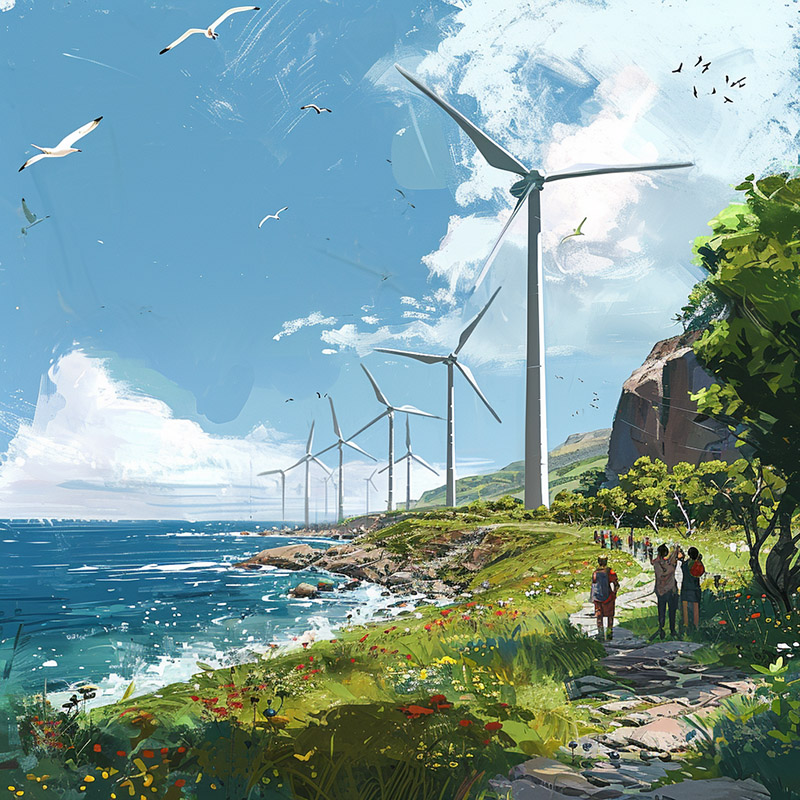
The United States should make a large investment in wind farming to help meet the nation's electricity needs and address global warming, two energy experts from Stanford's Department of Civil and Environmental Engineering have concluded.
Writing in the August 24, 2001 issue of the journal Science, Associate Professor Mark Z. Jacobson and Teaching Professor Gilbert M. Masters conclude that wind power is an abundant, clean and affordable alternative to coal and other fossil fuels.
Last year, wind-driven turbines produced less than 0.1 percent of America's electricity supply -- compared to 52 percent generated from coal, according to the U.S. Department of Energy. One reason that wind energy has lagged so far behind is the perception is that wind farms are more expensive to build and operate than coal-fired power plants -- a notion that Jacobson and Masters dispute.
"Much of the recent U.S. energy debate has focused on increasing coal use," they note. "Since the 1980s, though, the direct cost of energy from large wind turbines has dropped to 3 to 4 cents per kilowatt-hour, comparable with that from new pulverized-coal power plants. Given that health and environmental costs of coal are another 2 to 4.3 cents per kilowatt-hour, wind energy is unequivocally less expensive than is coal energy."
The authors point to the indirect costs of coal-generated power plants, including the production of smog that causes asthma and other respiratory illnesses; carbon dioxide emissions that contribute to global warming; and acid rain that destroys lakes and forests.
Jacobson and Masters also cite statistics from the Centers for Disease Control showing that coal dust kills some 2,000 U.S. mineworkers annually and has cost taxpayers approximately $35 billion in monetary and medical benefits to former miners since 1973.
"Shifting from coal to wind would address health, environmental and energy problems," note the authors. Wind is a clean source of energy, they add, and should be promoted and funded by federal and state governments.
A typical 1,500-kilowatt turbine costs about $1.5 million to install and roughly $18,000 to $30,000 a year to maintain -- a bargain in the long haul, according to Jacobson and Masters.
"The U.S. could displace 10 percent of coal energy at no net federal cost by spending three to four percent of one year's budget on 36,000 to 40,000 large wind turbines and selling the electricity over 20 years, recouping all costs," they argue.
The authors calculate that, by building approximately 250,000 new turbines, America could eliminate almost two-thirds of its coal-generated electricity, thereby reducing its 1999 greenhouse gas emissions to 7 percent below 1990 levels -- a goal originally proposed by the Clinton administration under the controversial 1997 U.N. Kyoto Protocol on climate change.
"If you want to solve this country's energy problem, the U.S. needs to consider some type of large-scale program," says Jacobson. "The federal government could either go into the energy business for itself, or it could foster wind energy through tax incentives that would catalyze private-sector investment."
State governments also should take the initiative, write Jacobson and Masters. They point out that energy-strapped California could obtain 10 percent more electricity from wind by spending less than 10 percent of its state budget for one year on the construction of 5,000 new turbines, then selling the electricity over 20 years to recover all costs.
Turbines are most efficient in fast winds, note the authors, and could provide needed revenue to farmers and ranchers in areas where mean annual wind speeds are highest -- including the Dakotas, Texas, coastal regions and large portions of the West and Northeast.
A downside of turbines is that they have been linked to the accidental deaths of migratory birds that get caught inside fast-moving propeller blades. Selecting sites out of migration paths can help solve this problem, observe Jacobson and Masters. They also point out that the loss of birds from new wind farms would be small compared to the current loss of forests, birds, fish and other wildlife from acid discharge caused by coal combustion.
The authors note that, last year, Germany produced nearly three times more wind-generated electricity than the U.S., and Denmark -- a country roughly half the size of Maine -- produced almost as much turbine power as the United States. Denmark and Sweden also have developed wind parks offshore, where winds are faster than over land.
"Clearly, the U.S. has not maximized its wind potential," conclude Jacobson and Masters. "Doing so would address health, environmental and energy problems."